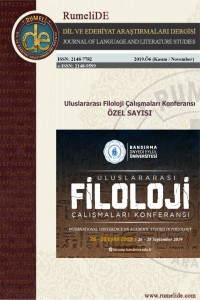Waltzes in Exile: Exilic spaces and female presence in Kenizé Mourad’s De la part de la princess morte
Öz
Regards
from the Dead Princess (1989), Kenizé Mourad’s much
acclaimed début novel, tells the story of Selma, an Ottoman princess whose life
traverses capitals, cultures and continents – Istanbul, Beirut, Badalpour, and
Paris during the interbellum years. Selma bears witness to key turning points
in a troubled period, namely the fall of empires, rise of nationalism, and
world wars. Her life story provides insight to cataclysmic events, and its
retelling in an errant narrative which weaves in female experiences that have
been silenced. There is a link between the shifts in places and those her inner
self undergoes. Moreover, the presence of dance as a means of self-expression
makes an apt point in discussing the development of Selma’s identity. This
paper traces the ways in which the novel represents exilic spaces and their
female experiencing through focus on displacement and practices of dance. By
juxtaposing the themes of exile, movement and dance this paper highlights the
complexity of the narrative and the circuitous forms of displacement.
Anahtar Kelimeler
Kaynakça
- Ahmed, S. (1999). Home and away. International Journal of Cultural Studies, 2(3), 329-347. Armianu, I. (2012). Kenizé Mourad and early eastern feminism, The Levantine Review, 1(2), 205-215. Butler, J. (1990). Gender Trouble: Feminism and the Subversion of Identity. London, England: Routledge. Daniels, J. (2015). The secret history of female muslim empowerment: a conversation with Kenizé Mourad. World Literature Today, 89(3-4), 16-19. Deringil, S. (1998). The Well-Protected Domains: Ideology and the Legitimation of Power in the Ottoman Empire 1876-1909. London: I.B. Tauris. De Ricaumont, J. (1988). De la part de la princesse morte. Revue Des Deux Mondes, 156-158 Dreyer, E & McDowall, E. (2012) Imagining the flâneur as a woman, Communicatio, 38:1, 30-44 Keyman, E. F. (2007). Modernity, secularism and Islam: the case of Turkey.” Theory Culture Society (24): 215-234. La Rocca F. (2017). A theoretical approach of the flâneur and the sensitive perception of the metropolis. Sociétés, 135(1), 9-17 Lionnet, F. (1991). Autobiographical voices: Race, Gender, Self-Portraiture. Ithaca: Cornell University Press. Mourad, K. (1987). De la part de la princesse morte. Paris: Robert Laffont (Le Livret de Poche) Mourad, K. (1989). Regards from the dead princess. London, Sydney, Auckland: Muller Mourad, K. (2000). Le jardin de Badalpour. Paris: Fayard. Peters, J.D. (1999). Exile, nomadism, and diaspora: the stakes of mobility in the western canon. Home, Exile, Homeland, ed. Hamid Naficy, London: Routledge, 17-45. Roy, S. (2010). Temple and dam, fez and hat: the secular roots of religious politics in India and Turkey. Commonwealth & Comparative Politics (48.2), 148-172. Sedgewick, E.K (1990). Epistemology of the Closet. Oakland, CA: University of California Press. Seyhan, A. (2001) Writing Outside the Nation. Princeton, N.J. and Oxford: Princeton University Press. Yerasimos, S. (1992). Istanbul 1914-1923 Demeures Ottomanes de Turquie. Ed. Stefanos Yerasimos. Paris: Albin Michel.
Öz
Kenizé Mourad’ın Saraydan Sürgüne (1987) adlı romanı Selma adındaki Osmanlı
prensesinin iki dünya savaşı arasında kıtalar, kültürler ve başkentleri kat
eden (İstanbul, Beyrut, Badalpour ve Paris) hikayesini konu alır. Selma
imparatorlukların çöküşü, milliyetçiliğin yükselişi ve dünya savaşları ile
örülmüş sorunlu bir dönemin kilit tarihine tanıklık etmektedir. Selma’nın bu
göçebe öyküsü yaşanan felaketlere ışık tutmanın yanı sıra susturulmuş ve
bastırılmış farklı kadın deneyimlerine de göndermede bulunmaktadır. Romanda
Selma’nın yaşadığı mekânsal değişimler ile içsel benliğinin yaşadığı başkalaşım
arasında bir bağlantı bulunmaktadır. Ayrıca, kendini ifade etme aracı olarak
dans kavramının varlığı, Selma’nın kimliğinin gelişimini tartışmak için uygun
bir noktaya getirmektedir. Bu makale, romanda bir mekân olarak sürgün
kavramının ve kadın varlığının ne şekilde temsil edildiğini ve metnin gidiş ve
dönüşler arasındaki gezici niteliğinin bu kavramları nasıl dönüştürdüğünü
incelemektedir. Bu bağlamda, sürgün, hareket ve dans temalarını yan yana
getirerek, anlatının karmaşıklığını farklı bir mercekle analiz etmektedir.
Anahtar Kelimeler
Kaynakça
- Ahmed, S. (1999). Home and away. International Journal of Cultural Studies, 2(3), 329-347. Armianu, I. (2012). Kenizé Mourad and early eastern feminism, The Levantine Review, 1(2), 205-215. Butler, J. (1990). Gender Trouble: Feminism and the Subversion of Identity. London, England: Routledge. Daniels, J. (2015). The secret history of female muslim empowerment: a conversation with Kenizé Mourad. World Literature Today, 89(3-4), 16-19. Deringil, S. (1998). The Well-Protected Domains: Ideology and the Legitimation of Power in the Ottoman Empire 1876-1909. London: I.B. Tauris. De Ricaumont, J. (1988). De la part de la princesse morte. Revue Des Deux Mondes, 156-158 Dreyer, E & McDowall, E. (2012) Imagining the flâneur as a woman, Communicatio, 38:1, 30-44 Keyman, E. F. (2007). Modernity, secularism and Islam: the case of Turkey.” Theory Culture Society (24): 215-234. La Rocca F. (2017). A theoretical approach of the flâneur and the sensitive perception of the metropolis. Sociétés, 135(1), 9-17 Lionnet, F. (1991). Autobiographical voices: Race, Gender, Self-Portraiture. Ithaca: Cornell University Press. Mourad, K. (1987). De la part de la princesse morte. Paris: Robert Laffont (Le Livret de Poche) Mourad, K. (1989). Regards from the dead princess. London, Sydney, Auckland: Muller Mourad, K. (2000). Le jardin de Badalpour. Paris: Fayard. Peters, J.D. (1999). Exile, nomadism, and diaspora: the stakes of mobility in the western canon. Home, Exile, Homeland, ed. Hamid Naficy, London: Routledge, 17-45. Roy, S. (2010). Temple and dam, fez and hat: the secular roots of religious politics in India and Turkey. Commonwealth & Comparative Politics (48.2), 148-172. Sedgewick, E.K (1990). Epistemology of the Closet. Oakland, CA: University of California Press. Seyhan, A. (2001) Writing Outside the Nation. Princeton, N.J. and Oxford: Princeton University Press. Yerasimos, S. (1992). Istanbul 1914-1923 Demeures Ottomanes de Turquie. Ed. Stefanos Yerasimos. Paris: Albin Michel.
Ayrıntılar
| Birincil Dil | Türkçe |
|---|---|
| Konular | Sanat ve Edebiyat |
| Bölüm | Türk dili, kültürü ve edebiyatı |
| Yazarlar | |
| Yayımlanma Tarihi | 21 Kasım 2019 |
| Yayımlandığı Sayı | Yıl 2019 RumeliDE 2019.Ö6 - Bandırma Onyedi Eylül Üniversitesi Uluslararası Filoloji Çalışmaları Konferansı |


